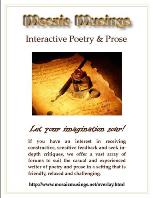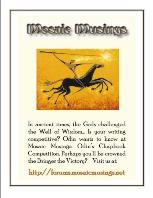 Aug 16 10, 03:16 Aug 16 10, 03:16
Post
#1
|
|
|
Group: Gold Member Posts: 3,822 Joined: 3-August 03 From: Florida Member No.: 10 Real Name: Elizabeth Writer of: Poetry Referred By:Lori Kanter |
I haven't written in a long while. With lack of something new and fresh to offer you, I dusted off this older Sonnet, my 2nd Sonnet infact and I am open to any suggestions and thoughts for improvement. It is a Reply Sonnet to Samuel Butler's "She was too kind, she woo'd so persistently..."
Could I Belie? Would I have been so wise to love without a heart to break, a voice to vow and dreams of blissful nights-to offer less? It seems a waste of time to entertain this doubt. Would I be more adored by you, if I had used you as a fool -- had played a game and masked my care in deeper shades of shame? To hide behind feigned words implies a lie; perhaps this voice that says "I will be true," or speaks in written verse, enkindled dear, by hands that stop to wipe away a tear, could never spark a kindred flame in you? Should I decide to hide a better me, or speak of love and hope to set it free. ·······  ······· ·······Nominate a poem for the InterBoard Poetry Competition by taking into careful consideration those poems you feel would best represent Mosaic Musings. For details, click into the IBPC nomination forum. Did that poem just captivate you? Nominate it for the Faery award today! If perfection of form allured your muse, propose the Crown Jewels award. For more details, click here!
MM Award Winner   |
|
|
|
 |
Replies
| Guest_bombadil1247_* |
 Aug 17 10, 06:37 Aug 17 10, 06:37
Post
#2
|
|
|
Hi, Liz,
I'm going to put my pedant's hat on now and talk about Sonnet types and rhyme schemes. The Petrarchan or Italian Sonnet is composed of an octet rhymed abbaabba and a sestet rhymed either cdcdee or cdecde Here is Milton's On His Blindness to illustrate QUOTE When I consider how my light is spent (a) Ere half my days, in this dark world and wide, (b) And that one talent which is death to hide, (b) Lodged with me useless, though my soul more bent (a) To serve therewith my Maker, and present (a) My true account, lest he returning chide; (b) "Doth God exact day-labor, light denied?" (b) I fondly ask; but Patience to prevent (a) That murmur, soon replies, "God doth not need © Either man's work or his own gifts; who best (d) Bear his mild yoke, they serve him best. His state (e) Is Kingly. Thousands at his bidding speed © And post o'er land and ocean without rest; (d) They also serve who only stand and wait." (e) The Shakespearean or English Sonnet is composed in 3 quatrains and a couplet rhymed ababcdcdefefgg Look at his Sonnet 116 QUOTE Let me not to the marriage of true minds (a) Admit impediments, love is not love (b)* Which alters when it alteration finds, (a) Or bends with the remover to remove. (b)* O no, it is an ever fixéd mark ©** That looks on tempests and is never shaken; (d)*** It is the star to every wand'ring bark, © Whose worth's unknown although his height be taken. (d)*** Love's not time's fool, though rosy lips and cheeks (e) Within his bending sickle's compass come, (f)* Love alters not with his brief hours and weeks, (e) But bears it out even to the edge of doom: (f)* If this be error and upon me proved, (g)* I never writ, nor no man ever loved. (g)* A variant on the English form is the Spenserian sonnet, in which the rhyme scheme is, abab, bcbc, cdcd, ee Have a look at his Happy ye leaves! whenas those lily hands QUOTE Happy ye leaves! whenas those lily hands, (a) Which hold my life in their dead doing might, (b) Shall handle you, and hold in love's soft hands, (a) Like captives trembling at the victor's sight. (b) And happy lines on which, with starry light, (b) Those lamping eyes will deign sometimes to look,© And read the sorrows of my dying sprite, (b) Written with tears in heart's close bleeding book. © And happy rhymes! bathed in the sacred brook © Of Helicon, whence she derived is, (d) When ye behold that angel's blessed look, © My soul's long lacked food, my heaven's bliss. (d) Leaves, lines, and rhymes seek her to please alone, (e) Whom if ye please, I care for other none. (e) All examples taken from Wikipedia Sonnet Types I've done this so that you can see how there is a deliberate contrast between the early lines and the closing ones. In this Sonnet, you lose that contrast in the couplet because of the abbacddceffegg rhyme scheme - you have pairs of rhymed lines throughout. Butler's piece is a straightforward English Sonnet and I think it was a good idea to answer it in a different format but you haven't been consistent here. The Italian variant would probably be the best option for this in that the octet could be used to explore the 'Would I have been so wise?' question while the sestet allows its rebuttal. Of course, you may not want to be that formal in your Sonnet, and that is your choice, but I feel that the contrast would emphasise the gulf between the two writers ie male/female POV's. Should you decide to go with the present layout, I will come back and offer my comments later, Jim |
|
|
|
 Aug 29 10, 02:11 Aug 29 10, 02:11
Post
#3
|
|
|
Group: Gold Member Posts: 3,822 Joined: 3-August 03 From: Florida Member No.: 10 Real Name: Elizabeth Writer of: Poetry Referred By:Lori Kanter |
Hi Jim, I am so grateful for you to have offered examples to show where the weakness within this lies. I also agree greatly with your thoughts that the contrast in choice of a more modern voice just might enhance the difference in feelings - etc ... This was written back in 2002 and I would love to do something different with this ... YOu've come and left some wonderful ideas ... Hugs, Liz ·······  ······· ·······Nominate a poem for the InterBoard Poetry Competition by taking into careful consideration those poems you feel would best represent Mosaic Musings. For details, click into the IBPC nomination forum. Did that poem just captivate you? Nominate it for the Faery award today! If perfection of form allured your muse, propose the Crown Jewels award. For more details, click here!
MM Award Winner   |
|
|
|
Posts in this topic
 AMETHYST Could I belie Aug 16 10, 03:16
AMETHYST Could I belie Aug 16 10, 03:16 
 JLY Liz,
I am a bit of a disadvantage because I am not... Aug 16 10, 05:39
JLY Liz,
I am a bit of a disadvantage because I am not... Aug 16 10, 05:39 
 AMETHYST Hi John,
Thank you for stopping in ... Although ... Aug 16 10, 10:55
AMETHYST Hi John,
Thank you for stopping in ... Although ... Aug 16 10, 10:55 
 ohsteve Liz, definetly speak of love and set it free. I li... Aug 16 10, 11:13
ohsteve Liz, definetly speak of love and set it free. I li... Aug 16 10, 11:13 
 AMETHYST Hi Steve,
Thank you for stopping in on this old ... Aug 17 10, 05:48
AMETHYST Hi Steve,
Thank you for stopping in on this old ... Aug 17 10, 05:48 
 Eisa Hey Liz!
I'm so pleased to see you again.... Aug 17 10, 17:24
Eisa Hey Liz!
I'm so pleased to see you again.... Aug 17 10, 17:24 
 AMETHYST Hey Snow ...
Thank you for stopping... I think y... Aug 29 10, 02:14
AMETHYST Hey Snow ...
Thank you for stopping... I think y... Aug 29 10, 02:14 
 heartsong7 Even though written as a response poem,this lovely... Sep 11 10, 10:09
heartsong7 Even though written as a response poem,this lovely... Sep 11 10, 10:09 
 AMETHYST Hey Sue,
I am blushing. As I am your greatest f... Sep 11 10, 22:06
AMETHYST Hey Sue,
I am blushing. As I am your greatest f... Sep 11 10, 22:06 
 Eisa Liz - I've come back to read this a number of... Sep 13 10, 15:57
Eisa Liz - I've come back to read this a number of... Sep 13 10, 15:57 
 AMETHYST I agree. I have been comtemplating what Jim had su... Sep 13 10, 19:17
AMETHYST I agree. I have been comtemplating what Jim had su... Sep 13 10, 19:17 
 anaisa Hi Liz,
I really enjoyed this. It's somewhat... Sep 17 10, 00:35
anaisa Hi Liz,
I really enjoyed this. It's somewhat... Sep 17 10, 00:35 
 AMETHYST Thank you for stopping in Karen - I appreciate the... Sep 19 10, 22:21
AMETHYST Thank you for stopping in Karen - I appreciate the... Sep 19 10, 22:21 1 User(s) are reading this topic (1 Guests and 0 Anonymous Users)
0 Members:
  |

|
Lo-Fi Version | Time is now: 29th November 2025 - 08:14 |

















